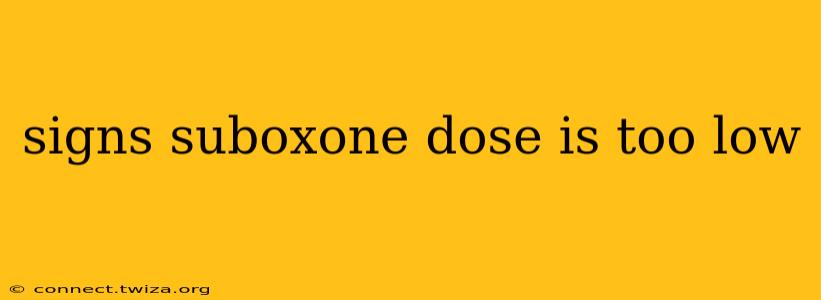Opioid addiction is a serious health crisis, and Suboxone (buprenorphine/naloxone) plays a vital role in medication-assisted treatment (MAT). However, finding the right Suboxone dose is crucial for successful recovery. If your dose is too low, you might experience several unpleasant and potentially dangerous symptoms. This article will explore the key signs that your Suboxone dose may need adjusting, helping you understand when to discuss your concerns with your doctor.
Understanding Suboxone and its Role in Treatment
Before diving into the signs of an insufficient dose, it's important to understand that Suboxone is a partial opioid agonist. This means it binds to opioid receptors in the brain, reducing cravings and withdrawal symptoms, but without producing the same euphoric effects as full opioid agonists like heroin or oxycodone. The right dose varies significantly depending on individual factors, making close monitoring by a healthcare professional absolutely essential.
Common Signs Your Suboxone Dose Is Too Low
Several indicators may suggest your current Suboxone dose is inadequate. Recognizing these signs promptly and discussing them with your doctor is critical for optimizing your treatment.
1. Persistent or Increased Opioid Cravings
A primary function of Suboxone is to curb cravings. If you’re still experiencing intense cravings for opioids, even after starting Suboxone, or if your cravings are increasing, it's a strong sign your dose might be too low. This doesn't necessarily mean you're experiencing the cravings at the same intensity as before, but it is a clear signal that further attention should be given to your dosage.
2. Withdrawal Symptoms
Experiencing withdrawal symptoms, such as muscle aches, anxiety, nausea, insomnia, or intense drug cravings, despite taking Suboxone, indicates that your current dose isn't effectively suppressing opioid withdrawal. This is a clear indication that an increase in medication may be necessary.
3. Intense Drug Cravings While in Between Doses
This can be a particularly significant indicator. If you find your cravings spike intensely before your next scheduled dose, the current dose may be insufficient to bridge the time period, thus requiring further attention from your doctor.
4. Continued Use of Other Opioids
If you're still using other opioids despite taking Suboxone, it's a serious red flag that your Suboxone dose is inadequate to meet your needs. This should be reported immediately to your physician. This behavior can have serious implications for your health and recovery.
5. Uncontrolled Mood Swings and Irritability
Suboxone can, in some instances, stabilize mood; however, if the dose is too low, it might not provide enough relief, leading to greater emotional volatility, increased irritability, and anxiety.
6. Difficulty with Daily Functioning
A too-low dose might not provide sufficient relief from the physiological and psychological effects of opioid withdrawal, making it challenging to perform everyday tasks, maintain relationships, or go to work or school. This suggests a lack of adequate medication.
What to Do if You Suspect Your Suboxone Dose Is Too Low
If you're experiencing any of these signs, it's crucial to communicate openly with your doctor. Never attempt to adjust your Suboxone dose on your own. Improper adjustments can lead to serious complications, including overdose. Your doctor can assess your situation and determine if an adjustment is necessary, and, if so, will guide you through the process safely.
Remember, open communication with your healthcare team is vital for successful Suboxone treatment. Don't hesitate to voice your concerns and work collaboratively with them to achieve the best possible outcomes for your recovery. Your health and well-being are paramount.
Disclaimer: This information is for educational purposes only and does not constitute medical advice. Always consult with your healthcare provider before making any changes to your medication regimen.
